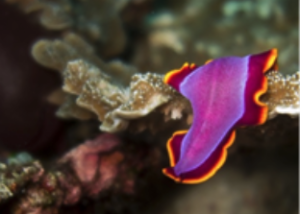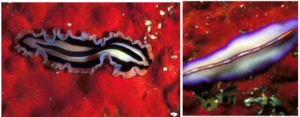Have you ever wondered what happens to a research collection when a researcher retires? Believe it or not, many end up in the dumpster! Fortunately, OGL now offers scientists another option. OGL’s new Repository to the Rescue program is reaching out to retiring researchers, giving their most valuable specimens a second chance to support research and conservation efforts around the world.
The inspiration for this program came from Dr. Marian Litvaitis, a professor at the University of New Hampshire. Upon retirement, Dr. Litvaitis reached out to OGL to propose a new home for her extensive collection of marine polyclad flatworms! Often mistaken for sea slugs, these ribbon-like invertebrates are bilaterally symmetrical (their right side mirrors their left) with neither a true body cavity nor a complete digestive system.

Dr. Litvaitis’ favorite flatworm, Pseudoceros ferrugineus, in Dumaguete, Philippines. Photo credit: Kris Mikael Krister
These fascinating worms are found worldwide in marine waters, and a few species can even be found in freshwater. They are most common in the tropics and subtropics, but have also been identified in the Antarctic. Dr. Litvaitis’ lab has even described new species found in wood deployments at depths greater than 2,600 meters! Dr. Litvaitis and the late Dr. Leslie Newman of Southern Cross University in Lismore, Australia, were among the first scientists to use molecular-based evidence to develop a family tree to understand the evolution of polyclads.

Pseudobiceros gratus (left) and Pseudoceros bifurcus (right) are part of Dr. Litvaitis’ collection. Photo credit: Dr. Marian Litvaitis
According to Dr. Litvaitis, it’s hard not to be drawn to the spectacular colors and patterns displayed by polyclad flatworms, which are often used to advertise their toxicity to potential predators. While some flatworms contain high levels of tetrodotoxin, the same poison that makes puffer fish so deadly, others are harmless and mimic toxicity.
We’re thrilled that Dr. Litvaitis’ entire collection is now housed at OGL and can be used by scientists around the world. Through Repository to the Rescue, OGL is reaching out to more retiring researchers to save other valuable collections from an untimely demise. Stay tuned to find out about more exciting rescues!
Want to contribute to OGL’s mission to preserve researchers’ collections? By making a gift to OGL,you can help make collections like Dr. Litvaitis’ incredible marine flatworms available to the greater scientific community.
